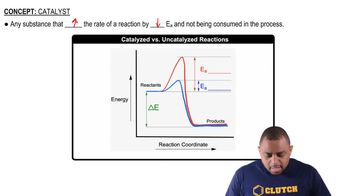Here are the essential concepts you must grasp in order to answer the question correctly.
Reaction Mechanism
A reaction mechanism describes the step-by-step sequence of elementary reactions by which overall chemical change occurs. Understanding the mechanism of nitramide decomposition is crucial, as it reveals how reactants are transformed into products and how intermediates are formed. Each step can have different rates, influencing the overall reaction rate.
Recommended video:
Reaction Mechanism Overview
Effect of pH on Reaction Rates
The pH of a solution can significantly affect the rates of chemical reactions, particularly those involving acids and bases. In this case, adding HCl will increase the concentration of H+ ions, potentially altering the equilibrium and the rate of the reaction by affecting the availability of hydroxide ions (OH-) that participate in the mechanism.
Recommended video:
Catalysis
Catalysis involves the acceleration of a chemical reaction by a substance called a catalyst, which is not consumed in the reaction. In the context of this question, adding HCl may act as a catalyst by providing protons that can shift the reaction equilibrium or enhance the rate of the reaction, thereby influencing the overall kinetics of nitramide decomposition.
Recommended video:
Catalyzed vs. Uncatalyzed Reactions
 Verified step by step guidance
Verified step by step guidance


